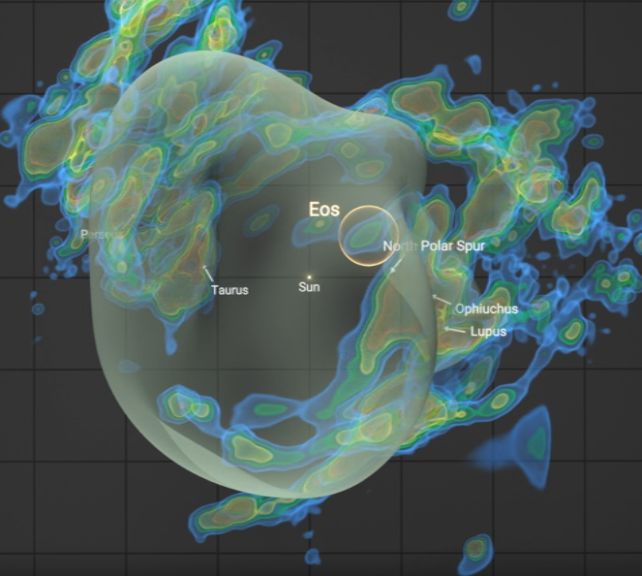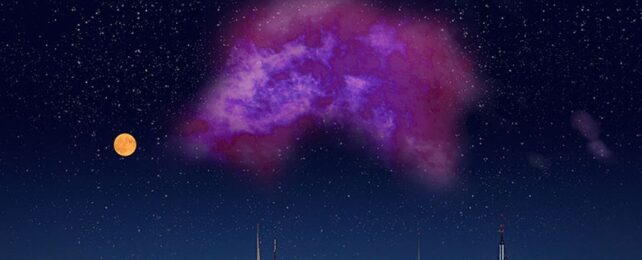A giant object that has been lurking in the relative galactic vicinity of the Solar System this entire time has just been unmasked in all its enormous, invisible glory.
Just 300 light-years away, at the edge of the Local Bubble of space, astronomers have discovered a huge, crescent-shaped cloud of molecular hydrogen, the basic building block of everything in the Universe.
It's the first time scientists have managed to discover molecular material in interstellar space by looking for the glow of far-ultraviolet light. Its discoverers have named the cloud Eos, after the ancient Greek goddess of the dawn.
"This is the first-ever molecular cloud discovered by looking for far-ultraviolet emission of molecular hydrogen directly," says astrophysicist Blakesley Burkhart of Rutgers University in the US. "The data showed glowing hydrogen molecules detected via fluorescence in the far-ultraviolet. This cloud is literally glowing in the dark."
When you look into the night sky, the stars and planets look like glittering diamonds strewn across velvet. You see pinpricks of light, but not much between them. Interstellar space, however, is not empty. Tenuous molecular material drifts between the stars, sometimes coming together in a higher-density cloud.
This material is the stuff from which the stars are born, but it's hard to see when it's not all clumped together to form a nebula. Stars are very, very bright, and the glow emitted by the interstellar medium is very, very faint.
There are ways to detect it; for instance, light traveling through a cloud of something can be subtly changed, either in the orientation of the wave, or a shift in the frequency.
One theory about the matter in interstellar space is that it may have been evading detection. One of the most popular tracers that astronomers look for, for example, is carbon monoxide, and it has yielded a lot of information about the interstellar medium. But what about clouds that don't have a lot of carbon monoxide?
Burkhart and her colleagues took a different approach, analyzing publicly released observations collected by South Korea's STSat-1 ultraviolet space telescope.
Hydrogen makes up around 90 percent of the visible Universe by atoms, and 73 percent by mass. Molecular hydrogen fluoresces in far-ultraviolet when irradiated by ultraviolet starlight, so the researchers focused their efforts on searching for a strong emission associated with this interaction.
This is what led them to Eos, and enabled them to map its size and shape. It's roughly crescent-shaped and has a diameter of about 80 to 85 light-years. Within that contour, it contains around 2,000 solar masses' worth of hydrogen, representing around 36 percent of the total mass of the cloud.

If we could see it with our eyes in the night sky, Eos would be 40 times the width of the full Moon.
This material within the cloud, the team determined, is likely being evaporated by the stars around it, a process called photodissociation. It's dissipating at a rate of around 600 solar masses per million years, and will be totally gone in around 5.7 million years' time.
That's not very long, on cosmic timescales.
"When we look through our telescopes, we catch whole solar systems in the act of forming, but we don't know in detail how that happens," Burkhart says. "Our discovery of Eos is exciting because we can now directly measure how molecular clouds are forming and dissociating, and how a galaxy begins to transform interstellar gas and dust into stars and planets."
What's even more exciting is that the work shows a viable way to search for the heretofore invisible molecular clouds that are lurking throughout the Milky Way, and even the wider Universe. It'll offer new insight into our own galaxy's history of star formation, and how the process has taken place across the vastness of space and time.
"The use of the far-ultraviolet fluorescence emission technique could rewrite our understanding of the interstellar medium, uncovering hidden clouds across the galaxy and even out to the furthest detectable limits of cosmic dawn," cosmologist Thavisha Dharmawardena of New York University says.
The research has been published in Nature Astronomy.
